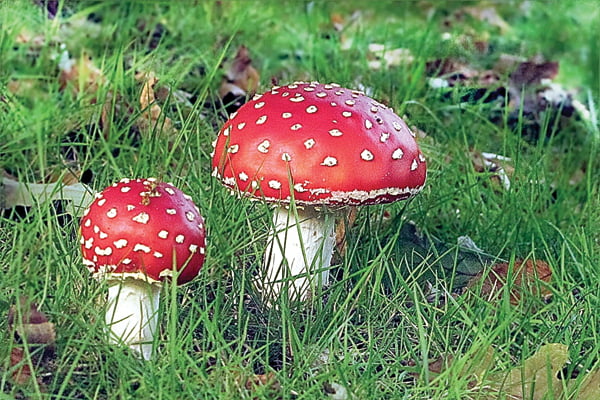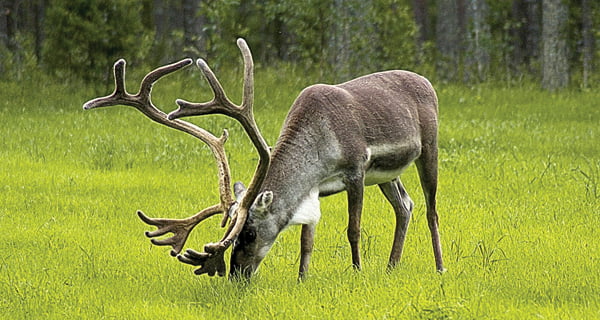
Ken Springer
Watoga Park Foundation
What do Vikings, fairies, reindeer and the CIA have in common?
A mushroom.
Amanita muscaria is a mushroom steeped in legend and myth. The red-capped variation of this species is often called a “toadstool” because of its familiar image in folk tales and its relationship with gnomes and fairies. This image has resulted is a general belief that Amanita muscaria, like fairies and leprechauns, is nothing but pure fantasy.
But I am here to tell you that Amanita muscaria is not only not a toadstool nor a myth, but that it exists. As for toadstools, they are every bit as real as unicorns. The word harkens back to European children’s stories depicting toads and fairies lounging upon the polka-dotted bright red caps of muscaria.
Some people erroneously think that poisonous mushrooms are called toadstools. The fruiting body of fungus is called a mushroom, whether it is edible or poisonous. So when you come upon a mushroom in the forest, no matter its shape, color or edibility, it is still just a mushroom.
We will get around to the CIA, Vikings, and even reindeer, but first, we need to take a closer look at this storied mushroom called Amanita muscaria.
First off, it is a member of the genus Amanita of which there are many different species. Among this large family of mushrooms are two of the most lethal mushrooms in the world, Amanita virosa, and Amanita phalloides.
Amanita virosa is common in West Virginia, whereas Amanita phalloides has yet to be found in our state. Together they represent well over 90 percent of the mushroom fatalities in North America. Amanita muscaria shares some of the same characteristics, but the cap is radically different in color.
The caps can range in color from yellow to candy-apple red, depending on the growing region. Here in West Virginia, you can expect to find muscaria sporting the yellow-orange color caps. Judging from the graphics in vintage children’s books, the bright red mushrooms are the preferred color of gnomes and fairies.
Amanita muscaria is partial to oak, pine and spruce forests, so this is where you are most likely to find them. Sometimes they are found growing in rings, further establishing their connection to fairies and other woodland fantasy beings. Several species of mushrooms grow in circles – often referred to as “fairy rings,” even among serious mushroom collectors.

Most mushroom guide books declare the Amanita muscaria to be poisonous. *But not so toxic that they are considered lethal like the two Amanitas discussed above.
A common name for muscaria is Fly Agaric, so-called because it was once thought that soaking the cap in milk would attract flies and kill them, although it appears to only inebriate them.
Human consumption of muscaria can have a range of effects. Everything from nausea to inebriation, and even hallucinations, depending upon the concentration of psychoactive substances.
In some cases, the effect can include enhanced aggressiveness and alleged abilities of super-perception, generally classified as paranormal.
One particular case in New Jersey, illustrating this response, involved a patient hospitalized for consuming a species of mushroom that contains the same psychoactive compounds as muscaria. He had to be restrained for several days after repeatedly attempting to harm the hospital staff. **
And that leads us to the Vikings, who were no strangers to the potent effects of Amanita muscaria.
The Nordic Berserkers were an elite group of warriors who went into battle with a little help from Amanita muscaria. The impact of eating this mushroom was said to reduce fear and enhance rage.
These men and women wore no armor, wearing wolf and bearskins and depending only on their ferocity to win battles. Which they usually did. They must have been a fearsome sight as they entered sleepy villages at daybreak, screaming and slashing.
In Greece and portions of the Middle East, Amanita muscaria was used by warriors for the same purpose, but with a twist. The mushrooms were allegedly milked by squeezing them between boards and mixing the juice with goat’s milk, which the soldiers would then drink.
In another variation of these stories, young boys were forced to eat the Amanita muscaria. The urine from these lads would be captured and drunk by the soldiers. Apparently, it was believed that the psychoactive compounds were more concentrated in the urine and would get in the system faster by using this method.
Among the effects reported were some that suggest abilities of extra-sensory perception (ESP), including pre-cognition and the ability to see through solid objects such as shields and barricades.
During the Cold War, both the CIA and the Russians were engaged in research into various forms of ESP. This type of research was an attempt to have an advantage over the other in matters of intelligence.
It is common knowledge that the CIA was funding research programs on remote viewing and psychoactive drugs. *** One such program, utilizing the results of an unwitting third-party researcher, looked at possible uses for the psychoactive properties of Psilocybin and Amanita muscaria. Both are hallucinogenic mushrooms, sometimes referred to as “magic mushrooms.”
The results of this research are not clear, particularly with respect to intelligence value. It is commonly rumored that one aspect of great interest was the ability to “see through walls” and powers of anomalous cognition. **** Although it is doubtful that the hoped-for results were realized, it is easy to see how these abilities would significantly advantage the field of spycraft.
I have a dear friend who once confessed a story to me. And if she ever happens to read this, I will have to enter the Witness Protection Program. She and her sister-in-law went to Finland for the express purpose of cross-county skiing under the Aurora Borealis. What she never, ever, ever expected to see was a reindeer.
Why? Because she thought they were mythical creatures invented to help Santa Claus deliver gifts.
Reindeer and Amanita muscaria are real; fairies and unicorns? Not so much.
So what do reindeer do after a long night of delivering gifts to children all over the world? They head out into the spruce where they indulge in a few Amanita muscaria and stumble home through the woods under the Aurora borealis.
It is true, reindeer do occasionally get inebriated by eating Amanita muscaria.
I hope that you have enjoyed this little essay on a fabled mushroom, and please note my new and improved email address.
From the mountains of Pocahontas County,
Ken Springer
Ken1949bongo@gmail.com
* Fatalities from consuming Amanita muscaria are rare, but that does not mean it is safe to eat them. And please, never consume any mushroom without first making a positive identification.
**Common Poisonous Plants and Mushrooms. Nancy J. Turner and Patrick von Aderkas.
***The Rockefeller Commission Report on the CIA, 1975.
**** Transfer of information through unknown means.


